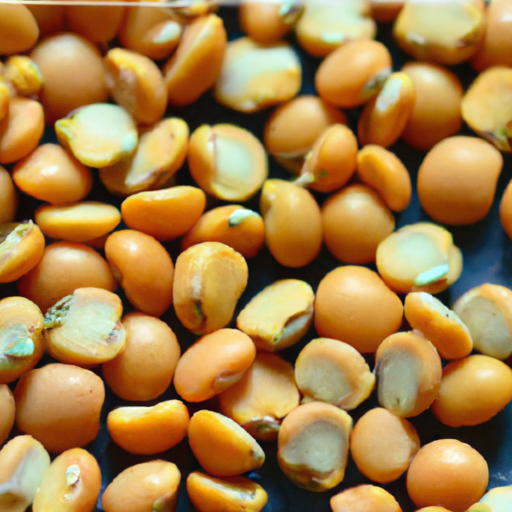Brown Chickpeas: A Nutritious and Versatile Ingredient
When it comes to legumes, chickpeas are always a crowd favorite. But have you ever tried their lesser-known cousin, brown chickpeas? These tiny legumes, also known as kala chana, are a game-changer in the culinary world. With their unique taste, versatility, and impressive nutritional profile, brown chickpeas are definitely worth incorporating into your cooking repertoire.
Taste and Texture
Brown chickpeas have a distinct flavor that sets them apart from their more common beige counterparts. They offer a nuttier and earthier taste, with a slightly firmer texture. Once cooked, these hearty legumes maintain their shape and deliver a delightful bite.
Common Uses in Cooking
Incorporating brown chickpeas into your cooking opens up a myriad of possibilities. From simple salads to aromatic curries, these legumes can elevate any dish. Here are a few ways to enjoy the flavorsome brown chickpeas:
Curries and stews: Brown chickpeas are a natural choice for curries and stews. Their robust flavor and texture make them an ideal ingredient to absorb and harmonize with various spices, creating a rich and satisfying dish.
Salads: Toss some cooked brown chickpeas into your salads for an extra protein boost. Their firm texture adds a delightful crunch, while their nutty flavor complements a variety of vegetables and dressings.
Snacks: Roasted brown chickpeas are a fantastic alternative to unhealthy, processed snacks. Coat them with spices and roast them until they become crispy bite-sized treats that you won’t be able to resist.
Hummus: Take your hummus game to the next level by making it with brown chickpeas. The earthy flavor adds depth to the traditional recipe, resulting in a unique and delicious dip.
Nutritional Value
Beyond their culinary charm, brown chickpeas pack a punch when it comes to nutrition. These legumes are an excellent source of plant-based protein, fiber, vitamins, and minerals. Here’s a breakdown of their nutritional highlights:
Protein: Brown chickpeas are a great plant-based source of protein, making them an ideal choice for vegetarians and vegans. Including them in your meals can help meet your daily protein needs.
Fiber: As with all chickpeas, brown chickpeas are rich in dietary fiber. Fiber aids digestion, supports weight management, and promotes overall gut health.
Vitamins and Minerals: Brown chickpeas are a good source of vitamins and minerals, including folate, iron, magnesium, and zinc. These nutrients play essential roles in various bodily functions, such as energy production and immune support.
Interesting History and Facts
Chickpeas, including the brown variety, have been an important part of human diets for thousands of years. They have a fascinating history deeply rooted in many cultures around the world. Here are a few interesting facts about brown chickpeas:
Indian Cuisine: Brown chickpeas are widely used in Indian cuisine, where they are known as kala chana. They feature prominently in popular dishes like chole (chickpea curry) and are a beloved staple in vegetarian and vegan diets.
Versatile Ingredient: Due to their versatility, brown chickpeas can be found in a range of traditional recipes worldwide. From Middle Eastern stews to Mediterranean salads, these legumes have found their way into various culinary traditions.
Farm-to-Table: By including brown chickpeas in your meals, you can support sustainable and local agriculture. Chickpeas are drought-resistant crops that require less water than other alternatives, making them an environmentally-friendly choice.
So, the next time you’re planning your meals, don’t forget to consider the mighty brown chickpeas. With their unique flavor, versatility in the kitchen, and impressive nutritional profile, they truly deserve a spot on your plate. Whether you’re a curry enthusiast or a salad lover, brown chickpeas are here to add their nutty charm to your culinary adventures.
Brown Chickpeas
Origin: Brown chickpeas, also known as Desi or Bengal gram, are native to the Indian subcontinent and are believed to have been cultivated for thousands of years. They are a staple in Indian, Pakistani, and Bangladeshi cuisine.
Common Uses: Brown chickpeas are commonly used in various recipes, both as whole or split legumes. They are frequently used to make popular dishes like Chana Masala, which is a spiced chickpea curry. Brown chickpeas can also be ground into flour (besan) and used to make snacks like pakoras or a batter for savory pancakes.
Nutritional Benefits: Brown chickpeas are a nutritious ingredient. They are an excellent source of plant-based protein, dietary fiber, and several essential minerals such as iron, manganese, and phosphorus. Additionally, they contain vitamins like folate, vitamin B6, and vitamin K.
Unique Properties: Brown chickpeas have a nuttier flavor compared to their lighter-colored counterparts. They have a dense texture and tend to hold their shape well when cooked. Due to their higher fiber content, they have a lower glycemic index compared to some other legumes, which can be beneficial for blood sugar control.
Historical Significance: Chickpeas, including brown chickpeas, have a long history of cultivation in the Indian subcontinent. They have been cultivated and consumed in this region for over 7,000 years. Chickpeas are also believed to have been grown in ancient Egypt and were even mentioned in the Bible. Their versatility and nutritional value have contributed to their popularity throughout history.
Remember, while brown chickpeas have various health benefits, it is important to consider individual dietary needs, cooking methods, and portion sizes to maintain a balanced diet.




Use the share button below if you liked it.
It makes me smile, when I see it.